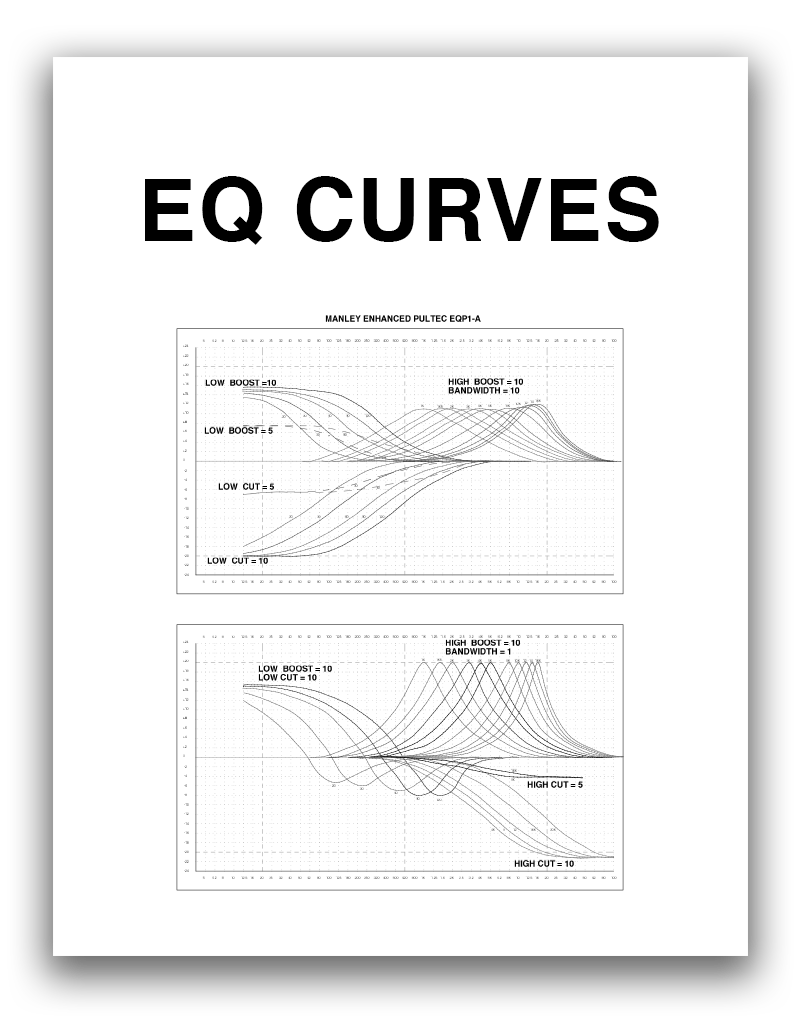
This single channel Mid Frequency EQ is the secret weapon for vocal, guitar, snare and all the other midrange instruments that are the meat of the mix.
“I use this unit primarily on vocals during mixdown and it shines…Built like all Manley gear, SOLID. I'd like another as it would be really useful on snare or guitar…Highly recommended.”
– Ted L, Manley Customer –

DETAILS
Specially useful for midband oriented instruments such as guitars, vocals, harmonicas, and violins, the MID FREQUENCY ENHANCED PULTEC EQ (MEQ-5 type) shares the same features and specifications as our 'EQP-1A' version. The differences lie in the passive EQ section: In the MID EQ, the DIP and PEAK controls function on much sharper bell-shaped curves centered on the selected frequencies, which gives the engineer-producer more precise control over the vitally important midrange and makes this unit indispensable for mastering engineers. The MID EQ also completely fills the frequency gaps between the low frequency and high frequency sections of our Enhanced Pultec EQP-1A type EQ; thus the combination of the two provides a most flexible palette of possibilities for tracking or mastering.
SPECIFICATIONS
Vacuum Tubes: 1 x 12AU7 gain and 1 x 12BH7 (or 6414 or 5965) White Follower Dual Triodes
MANLEY input transformer with pure nickel laminations potted in mu-metal case. 3K Ohm input Z
PHASE REVERSE switch for balanced XLR input
Alternate transformerless 1/4" HI-Z (5K Ohm) input
BYPASS switch & AUTO-MUTE w/warmup delay
Silent conductive plastic PEAK & SHELF controls
Sealed gold-contact Greyhill frequency select switches
Hi-current drive <50 Ohm LO-Z XLR & 1/4" outputs
Balanced Transformer Coupled XLR Outputs
Flat frequency response from 10Hz-70KHz
<0.01% THD @ 1kHz
S/N Ratio: 116 dB
Adjustable FEEDBACK / GAIN: Unity ±5 dB
Max. output: +30 dBv
Power consumption: 18 watts
Operating mains voltage: Units are purpose built for original destination country's mains voltage: 100V, 120V, or 220-240VAC as indicated on the serial number badge. Power transformer must be replaced in order to change mains operating voltage. 120VAC units may NOT be rewired to put the primaries of the power transformer in series for 220-240V operation or a large radiated field of hum will develop. If changing locations/voltages, the power transformer must be replaced with the dedicated one for the voltage at which it will operate.
Mains Voltage Frequency: 50~ 60Hz
Dimensions: 19" x 1 3/4" x 10" (occupies 1u)
Shipping weight: 12 lbs.

DOWNLOADS
HISTORICAL NOTES
We started building the MANLEY Enhanced Pultec EQ's in 1990 back at the old Vacuum Tube Logic of America factory. They were built there from 1990 until 1993 when the MANLEY LABS factory opened. The serial codes for those old early 1990's units are usually seen as hand-written ENHPLT###. Those oldest units use 5814 input tubes and 6350 output White Follower tubes. There is no substitute for a 6350! Unless you re-wire and swap pins 2&3 and 7&8 then you must keep using 6350 which is wired that way. Those old units also used ElectroSwitch brand NONshorting switches which are brass and black and white in body-of-the-switch color. They make some noise when switch position is changed. They should have been ordered as SHORTING switches. Newest units built at Manley Labs use shorting Grayhill brand switches. Grayhills have red bodies if you look at them.
Much has improved since those early days... Here is what we think was the very first Manley Pultec built in 1990 for BOP Studios in South Africa.
FREQUENTLY ASKED QUESTIONS
This thing isn’t working. I just bought it. For this amount of money, it needs to function.
OK, listen up: the XLR INPUTS and XLR OUTPUTS are TRANSFORMER-COUPLED so that means you HAVE TO have something connected to all of the pins.
PIN 1: GROUND
PIN 2: HOT (+) POSITIVE
PIN 3: COLD (-) NEGATIVE
You cannot "float" Pin 3. You can GROUND it if you are driving it from an unbalanced source. But you cannot hook it up to "nothing".
Pay attention when interfacing with some of these interfaces like your Apollo. If you are using TRS - XLR cables, make sure that it is wired:
TRS TIP = HOT (+) to XLR Pin 2
TRS RING = COLD (-) to XLR Pin 3
TRS SLEEVE = GROUND to XLR Pin 1
or
TS - XLR cable, make sure it is wired:
TS TIP = HOT (+) to XLR Pin 2
TS SLEEVE = GROUND to XLR Pin 1 AND Pin 3





